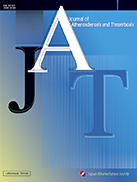16 巻, 5 号
選択された号の論文の23件中1~23を表示しています
- |<
- <
- 1
- >
- >|
Reviews
-
原稿種別: Review
2009 年 16 巻 5 号 p. 523-531
発行日: 2009年
公開日: 2009/11/11
[早期公開] 公開日: 2009/09/03PDF形式でダウンロード (763K) -
原稿種別: Review
2009 年 16 巻 5 号 p. 532-538
発行日: 2009年
公開日: 2009/11/11
[早期公開] 公開日: 2009/09/14PDF形式でダウンロード (219K)
Original Articles
-
原稿種別: Original Article
2009 年 16 巻 5 号 p. 539-545
発行日: 2009年
公開日: 2009/11/11
[早期公開] 公開日: 2009/11/10PDF形式でダウンロード (155K) -
原稿種別: Original Article
2009 年 16 巻 5 号 p. 546-552
発行日: 2009年
公開日: 2009/11/11
[早期公開] 公開日: 2009/09/03PDF形式でダウンロード (118K) -
原稿種別: Original Article
2009 年 16 巻 5 号 p. 553-559
発行日: 2009年
公開日: 2009/11/11
[早期公開] 公開日: 2009/11/10PDF形式でダウンロード (191K) -
原稿種別: Original Article
2009 年 16 巻 5 号 p. 560-567
発行日: 2009年
公開日: 2009/11/11
[早期公開] 公開日: 2009/09/14PDF形式でダウンロード (319K) -
原稿種別: Original Article
2009 年 16 巻 5 号 p. 568-575
発行日: 2009年
公開日: 2009/11/11
[早期公開] 公開日: 2009/09/14PDF形式でダウンロード (266K) -
原稿種別: Original Article
2009 年 16 巻 5 号 p. 576-585
発行日: 2009年
公開日: 2009/11/11
[早期公開] 公開日: 2009/09/18PDF形式でダウンロード (795K) -
原稿種別: Original Article
2009 年 16 巻 5 号 p. 586-593
発行日: 2009年
公開日: 2009/11/11
[早期公開] 公開日: 2009/09/03PDF形式でダウンロード (262K) -
原稿種別: Original Article
2009 年 16 巻 5 号 p. 594-603
発行日: 2009年
公開日: 2009/11/11
[早期公開] 公開日: 2009/11/10PDF形式でダウンロード (527K) -
原稿種別: Original Article
2009 年 16 巻 5 号 p. 604-610
発行日: 2009年
公開日: 2009/11/11
[早期公開] 公開日: 2009/09/16PDF形式でダウンロード (121K) -
原稿種別: Original Article
2009 年 16 巻 5 号 p. 611-620
発行日: 2009年
公開日: 2009/11/11
[早期公開] 公開日: 2009/09/03PDF形式でダウンロード (253K) -
原稿種別: Original Article
2009 年 16 巻 5 号 p. 621-626
発行日: 2009年
公開日: 2009/11/11
[早期公開] 公開日: 2009/11/10PDF形式でダウンロード (173K) -
原稿種別: Original Article
2009 年 16 巻 5 号 p. 627-632
発行日: 2009年
公開日: 2009/11/11
[早期公開] 公開日: 2009/11/10PDF形式でダウンロード (108K) -
原稿種別: Original Article
2009 年 16 巻 5 号 p. 633-640
発行日: 2009年
公開日: 2009/11/11
[早期公開] 公開日: 2009/09/03PDF形式でダウンロード (366K) -
原稿種別: Original Article
2009 年 16 巻 5 号 p. 641-653
発行日: 2009年
公開日: 2009/11/11
[早期公開] 公開日: 2009/09/24PDF形式でダウンロード (683K) -
原稿種別: Original Article
2009 年 16 巻 5 号 p. 654-661
発行日: 2009年
公開日: 2009/11/11
[早期公開] 公開日: 2009/11/10PDF形式でダウンロード (408K) -
原稿種別: Original Article
2009 年 16 巻 5 号 p. 662-673
発行日: 2009年
公開日: 2009/11/11
[早期公開] 公開日: 2009/11/10PDF形式でダウンロード (583K) -
原稿種別: Original Article
2009 年 16 巻 5 号 p. 674-683
発行日: 2009年
公開日: 2009/11/11
[早期公開] 公開日: 2009/11/10PDF形式でダウンロード (702K) -
原稿種別: Original Article
2009 年 16 巻 5 号 p. 684-690
発行日: 2009年
公開日: 2009/11/11
[早期公開] 公開日: 2009/09/14PDF形式でダウンロード (114K) -
原稿種別: Original Article
2009 年 16 巻 5 号 p. 691-697
発行日: 2009年
公開日: 2009/11/11
[早期公開] 公開日: 2009/09/03PDF形式でダウンロード (152K)
Case Report
-
原稿種別: Case Report
2009 年 16 巻 5 号 p. 698-701
発行日: 2009年
公開日: 2009/11/11
[早期公開] 公開日: 2009/08/27PDF形式でダウンロード (206K)
Communication
-
原稿種別: Communication
2009 年 16 巻 5 号 p. 702-705
発行日: 2009年
公開日: 2009/11/11
[早期公開] 公開日: 2009/09/03PDF形式でダウンロード (154K)
- |<
- <
- 1
- >
- >|
